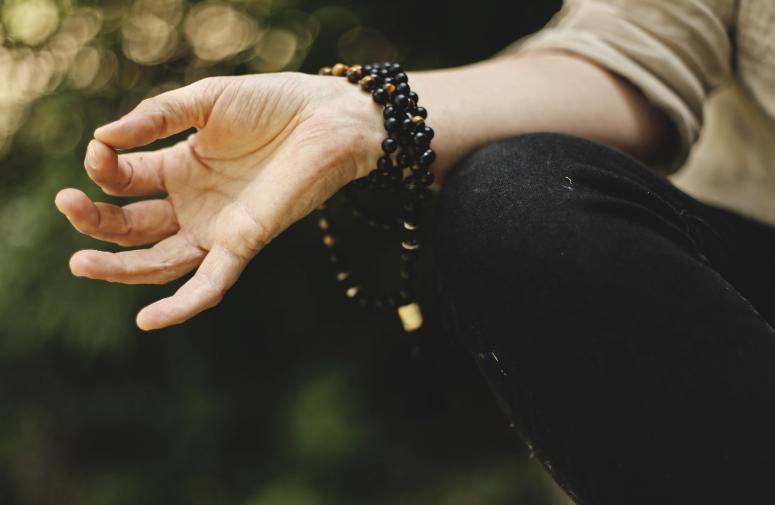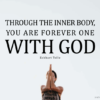
Connecting with your body can be a deeply relaxing and healing experience.
So what does it mean to connect with your body?
To put it simply, connecting with your body involves giving your body your conscious attention. In this article, let’s look at 5 techniques you can use to do this.
Benefits of connecting with your body
Before we look into the techniques, let’s have a look at just some of the many benefits you can reap by connecting with your body.
- Your consciousness expands and you become more self aware.
- You can help release suppressed emotions from your body.
- You become conscious of your emotions and hence gain better control over your emotions.
- You become calmer.
- You can tap into your body’s intelligence (develop intuition).
- You can enhance healing and relaxation.
12 practices to reconnect with your body
Reconnecting with your body is all about working with your attention; becoming aware of your attention and consciously focusing it within your body. The following simple exercises will help you do just that.
1. Breathe consciously
Conscious breathing is the easiest way to get in touch with your body. It simply involves staying conscious of your in-breath and out-breath; very similar to focused meditation.
This practice can be split into the following three levels to make it easier.
Level 1: Simply focus your attention on the sensation of air caressing the tip of your nostrils as you breathe in and breathe out.
Level 2: Take your attention inside your nose and feel the air caressing the inside of your nose as you breathe in and breathe out. Notice how to air feels cooler when you breathe in and warmer as you breathe out.
Level 3: Follow your breath all the way through, from the tip of your nostrils, through your windpipe, and within your lungs. Hold your breath for a few seconds and feel your inflated lungs. Similarly when you breathe out, feel your lungs deflate and the warm air going out of your system.
This method of following your breath all the way is known as Anapanasati, which is a meditation technique originally taught by Buddha.
If you are a beginner, start with the first level and practice it for a few weeks. Then move to the 2nd and 3rd levels as you feel comfortable.
While doing conscious breathing, your attention will invariably be pulled in by your thoughts. This is perfectly natural. Whenever this happens, bring your attention gently back to your breath.
This process of bringing your attention back over and over again will help develop your conscious mind and over time, you will not be affected by thoughts as much.
2. Chant OM
In this method, as you chant AUM, you consciously feel the vibrations it generates within your body – especially in and around your throat, chest and abdominal area.
When chanting AUM, you generate three different sounds ‘Aaa’, ‘Ooo’ and ‘Mmm’. You start with the ‘Aaa’ sound with your mouth open, slowly bringing your mouth to a close as the ‘Aaa’ sound changes to ‘Ooo’ and finally closing your mouth so you are left with the sound of a humming bee as in, ‘Mmmm’.
While chanting, take a deep breath and draw out the sounds as long as you comfortably can, emphasizing on the ‘mmm’ sound so it sounds something like this – ‘AaaaaOooooMmmmmmm’
Consciously feel the vibrations in your body as you chant. Make sure that you keep your body relaxed so the vibrations can permeate deep inside. When your body is tight, you will find it hard to sense the vibrations.
If you cannot feel the vibrations, you can place your hand on your throat or chest area and feel the vibrations that way.
3. Stay conscious of your heart
The heart literally represents your body as the heart is the one that supplies your body with life energy. In a way, the heart can be considered the center of your being.
So feeling your heart beats is a great way to get in touch with your entire body.
As with the breath, simply shift your attention to your heart beats and hold it there. As you feel your heart, allow your heart to slow down and relax. Keep your attention rested on your heart for as long as possible. If thoughts take your attention away (which they will), bring your attention gently back to your heart as you did during conscious breathing.
This practice has a multitude of benefits including the ability to calm your heart down when under stress.
If you find it difficult to feel your heart beats, you can place your hand on your heart and feel the beats that way.
4. Dance freely
Just turn on your favorite music and start moving. If you’re self-conscious, you may even try moving around with your eyes closed; just make sure you’re in a large area with no furniture that you might trip over.
You might feel awkward at first. That’s normal! Once you keep moving with the music, you’ll start to loosen up and your body will begin to take over. Allowing your body to move in a way that feels good, fun, and lively will help you to feel more embodied. Dancing is also a great way to raise your body’s vibration.
5. Practice yoga
The practice of yoga asana (the postures you practice on the mat) was created, in part, to bring your awareness back into your body. Any yoga class or yoga video on YouTube will lead you through moving your body in sync with your inhale and exhale, which acts as a “moving meditation” to restore bodily awareness.
6. Walk slowly and mindfully
We tend to rush around in our everyday lives, especially when we’re at work. Often, we speed-walk from one place to another with a device in our hands, hardly even paying attention to where we’re going. This pulls us out of a sense of present embodiment.
If you have a chance, try walking mindfully next time you stand up. Even if you slow down your pace by just a hair, you’ll be better able to notice how each step feels. Notice the way the floor feels under your feet. Breathe slowly as you walk, and notice your awareness returning to your body.
7. Do exercises that you enjoy
Any form of exercise– including dancing, practicing yoga, and walking, as mentioned above– will connect you to your body. However, the best exercise for helping you feel more embodied is exercise which you enjoy.
As you exercise, pay attention to the way your heart rate speeds up, and your breath quickens. Notice your body as it gets warmer. Become aware of any other sensations you feel, such as burning muscles or sweat beading on your forehead. These little mindful practices can turn any workout into a moving meditation.
8. Sing
Put on a song that you really love to sing along to, and belt it out in the shower, in the car, or in the kitchen while you’re making dinner. The vibrations will not only help to open your throat chakra, but they’ll also improve your connection to your body in the process. Bonus points if you dance along at the same time, of course!
9. Take a cold shower
Not only is taking a cold shower great for your nervous system and for stress resilience– this practice can help you to become more embodied, as well.
The best part is that you don’t have to stay in the shower for long. A few minutes will do the trick! Just start by breathing slowly and consciously as soon as you step into the shower. Pay attention to how your heart starts to race. When you get out of the shower, you’ll notice that your blood is rapidly pumping and that you feel more alert and embodied.
10. Get a massage
If it’s available to you, professional massages are incredible embodiment practices, and you’ll likely walk out of that parlor with a greater sense of awareness and wellbeing, too.
Next time you get a massage, focus your attention on each knead, each point of pressure. Stay aware of how every touch feels, breathing consciously through the entire thing. This is a meditation practice on its own if you allow it to be!
If parlor is not an option, you can also give yourself a self massage using automatic massagers.
11. Practice Consciously relaxing your body
Conscious relaxation is the practice of feeling your body from within and consciously relaxing body parts that are under tension. We unconsciously hold tension in various parts of our body and this method is excellent in releasing it.
To practice conscious relaxation, lie down on the floor or in your bed, close your eyes and start to feel your body from within. You can start from the soles of your feet and move your attention all the way to the crown of your head. If you do not want to follow a sequence, simply let your awareness run through your entire body. Along the way, if you sense clenched muscles, consciously relax them by letting go. If you feel mild sensations of pain, again, send the energy of love to that area and relax it.
Relaxing your body this way also helps release suppressed emotions and aids healing.
This is a great practice to do right before you go to sleep, as this will deeply relax you and aid deep sleep states.
This is a slightly advanced practice so if you find it difficult to feel your body from within, try starting out with conscious breathing and progressive muscle relaxation technique discussed earlier.
As you advance, you can also start to focus on the various chakras in your body, like the heart chakra, throat chakra, crown chakra etc. Focusing on chakras can help you bring your body into balance and harmony.
12. Practice progressive muscle relaxation
Another simple technique to bring attention within your body is to practice progressive muscle relaxation or PMR.
This technique involves tightening and relaxing various muscle groups in your body, including muscles of your legs, arms, shoulders, chest, stomach, back and neck. As you tighten and relax these muscles, stay conscious of the sensations you experience.
Here are a few examples:
A. Push your shoulders up towards your ears. Hold this position for around 5 to 10 seconds and release. Consciously feel the relaxing sensations in your shoulders, nape and upper back muscles. Repeat 2 to 3 times.
B. While keeping your head steady, raise your eyebrows as high as you can. Hold this position for 5 to 10 seconds. As you hold, feel the tension in the muscles of your forehead. Release after a few seconds and feel the relaxation across your entire forehead. Repeat 2 to 3 times.
C. Curl the toes of your foot downwards. Hold and feel the tension in your feet. Release after a few seconds and consciously study how the relaxing sensation feels like.
In a similar way, you can consciously tighten and relax the muscles in your entire body.
Here’s a good youtube video that offers a guided PMR exercise that you can follow.
In conclusion
So follow these 12 simple techniques to get your attention out of your mind and connect with your body.
As mentioned earlier, the more you practice body awareness (or introspective awareness as per neuroscience), the deeper you will connect with your body. There is even research that indicates that over time your brain creates new neural connections that allow you to get in touch with your body even more deeply. So even if you find it difficult at the beginning, keep practicing and it will get easier with time.
Also Read: 39 Ways for Becoming More Self Aware







